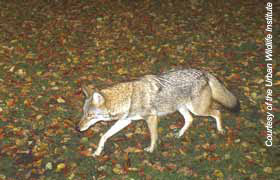Minimizing urban wildlife conflict is institute's goal
A multiyear study currently under way in Chicago aims to identify how best to minimize conflict between people and urban wildlife.

Chicago is an ideal laboratory for the work of the Urban Wildlife Institute, an initiative of the Lincoln Park Zoo. A city-sanctioned trapper caught and destroyed five coyotes this past spring in a Chicago suburb, and in 2008, police shot and killed a cougar on the city's far North Side.
Urban sprawl and green zones are resulting in increased numbers of encounters between people and wildlife, putting both at risk, according to Eric Lonsdorf, PhD, UWI director. The institute is in the early stages of developing standards for cities struggling to deal with wildlife relocation, rehabilitation, diseases, and conflicts.
Scientific study of human-wildlife interactions in urban environments is a much-needed endeavor, Dr. Lonsdorf said. Determining how construction and other man-made changes to the natural environment influence species distribution and abundance could ultimately lead to a predictive framework for more wildlife-sensitive land-use planning, he said.
"Responses to wildlife conflicts can be extreme, extending to extermination or relocation. Our goal is to integrate science with local values to find more pragmatic solutions," Dr. Lonsdorf explained.
The UWI study may also help scientists reduce zoonotic disease threats such as West Nile virus infection, rabies, and avian influenza.
To get a sense of the local wildlife, the institute has set up motion-sensitive cameras around the Chicagoland area. So far, the cameras have captured images of coyotes, foxes, skunks, and other mammals.
Many wildlife species are highly adaptive and able to thrive in urban areas. Still, Dr. Lonsdorf expects to find behavioral differences in how city animals behave compared with their rural counterparts. It's likely that the disease dynamics are also different.
"There are opportunities for unvaccinated pets to pick up diseases, especially from raccoons and coyotes, which carry a lot of diseases," he said. "The converse is that when pets aren't vaccinated, they can be disease sources." For instance, feline leukemia, a disease common to domestic cats but rare in large wild felids, has been diagnosed in Florida's endangered panther population.
Dr. Lonsdorf says at the Lincoln Park Zoo they're trying to practice what they preach in terms of coexisting with neighborhood wildlife. For instance, the exotic birds living at the zoo's outdoor lagoon are flightless and potentially easy pickings for coyotes, foxes, and other carnivores looking for a meal. Rather than trapping and relocating such predators or killing them, the zoo tries to teach them that the lagoon isn't a place to hunt. This is preferred to relocating or killing these animals, he said, since new predators are likely to take the former predators' places.
"We'd rather have one that's learned to avoid certain areas yet still be here and keep others out, rather than constantly bailing out the ocean," Dr. Lonsdorf said.
To learn more about the Urban Wildlife Institute, click here.